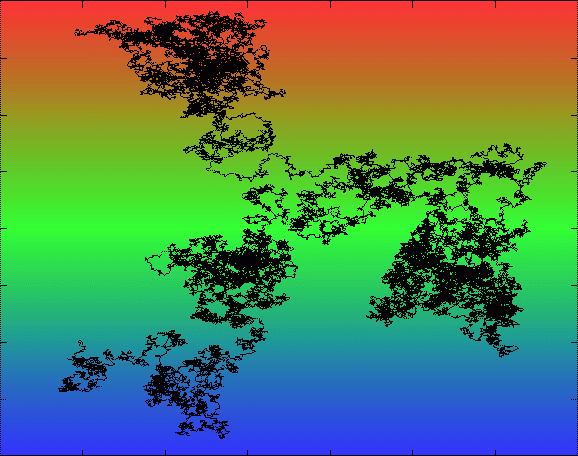
RANDOM WALKS AND SIMULATION
Summer 2002 REU:
About Random Walks, Simulation, and Related Links
 Q. "What is a random walk?" you might ask.
Here is a reasonably good description kindly provided by the
Merriam-Webster Collegiate
Dictionary on line:
Q. "What is a random walk?" you might ask.
Here is a reasonably good description kindly provided by the
Merriam-Webster Collegiate
Dictionary on line:
"a process (as Brownian motion or genetic drift) consisting of
a sequence of steps (as movements or changes in gene
frequency) each of whose characteristics (as magnitude and
direction) is determined by chance."
Perhaps the best place to start learning about random walks
is by reading two very nice expository articles by G. Slade who
is Professor of Mathematics at the University of British Columbia
in Vancouver, Canada:
- Random walks (1996). American Scientist, 84, 146-153.
- Self-avoiding walks (1994). The Mathematical Intelligencer, 16, 29-35.
Of course, there are also a number of textbooks that present this subject to
various degrees of mathematical sophistication.
Q. "What is a simulation?" you might ask next.
Here is a reasonably good description kindly provided by the
Merriam-Webster Collegiate
Dictionary on line:
"the imitative representation of the functioning of one
system or process by means of the functioning of another."
Q. "What do random walks look like?" This is
best answered by a simulation of the random walk. Here are
two links to simulations of random walks:
-
Jim Carlson, who is Professor of
Mathematics at the University of Utah, has created this Java applet
for simulations of 2-dimensional random walks.
This page also contains interesting historical references to the
connection to the Brownian motion, which is a
random process popularized by the 1905 work of Albert Einstein.
-
To see how 1-dimensional random walks evolve in time, also have a look at these
Java simulations of
Jim Carlson.
Related Links
We ran a search on Google,
and found "over 164,000 links!"
In other words, random walks really are an
important fact of life to many mathematicians and non-mathematicians alike.
The following is a minute sample of some interesting web pages related to random walks.
None of these URL's require a deeper understanding of random processes
than what is covered in a standard undergraduate course in probability. Here you can also
find a number of interesting simulations of 2-D random walks.
 Q. "What is a random walk?" you might ask.
Here is a reasonably good description kindly provided by the
Merriam-Webster Collegiate
Dictionary on line:
Q. "What is a random walk?" you might ask.
Here is a reasonably good description kindly provided by the
Merriam-Webster Collegiate
Dictionary on line:
